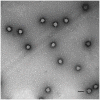Measurement of the accurate mass of a 50 MDa infectious virus
- PMID: 27501430
- PMCID: PMC5137368
- DOI: 10.1002/rcm.7673
Measurement of the accurate mass of a 50 MDa infectious virus
Abstract
Rationale: Bacteriophage P22 is believed to contain a total of 521 copies of 9 different proteins and a 41,724 base pair genome. Despite its enormous size and complexity, phage P22 can be electrosprayed, and it remains intact in ultra-high vacuum where its molar mass distribution has been measured.
Methods: Phage P22 virions were generated by complementation in Salmonella enterica and purified. They were transferred into 100 mM ammonium acetate and then electrosprayed. The masses of individual virions were determined using charge detection mass spectrometry.
Results: The stoichiometry of the protein components of phage P22 is sufficiently well known that the theoretical molar mass can be determined to within a narrow range. The measured average molar mass of phage P22, 52,180 ± 59 kDa, is consistent with the theoretical molar mass and supports the proposed stoichiometry of the components. The intrinsic width of the phage P22 mass distribution can be accounted for by the distribution of DNA packaged by the headful mechanism.
Conclusions: At over 50 MDa, phage P22 is the largest object with a well-defined molar mass to be analyzed by mass spectrometry. The narrow measured mass distribution indicates that the virions survive the transition into the gas phase intact. Copyright © 2016 John Wiley & Sons, Ltd.
Copyright © 2016 John Wiley & Sons, Ltd.
Figures



Similar articles
-
Charge detection mass spectrometry of bacteriophage P22 procapsid distributions above 20 MDa.Rapid Commun Mass Spectrom. 2014 Mar 15;28(5):483-8. doi: 10.1002/rcm.6809. Rapid Commun Mass Spectrom. 2014. PMID: 24497286 Free PMC article.
-
Hydrogen exchange dynamics of the P22 virion determined by time-resolved Raman spectroscopy. Effects of chromosome packaging on the kinetics of nucleotide exchanges.J Mol Biol. 1994 Aug 5;241(1):68-82. doi: 10.1006/jmbi.1994.1474. J Mol Biol. 1994. PMID: 8051708
-
Intravirion DNA Can Access the Space Occupied by the Bacteriophage P22 Ejection Proteins.Viruses. 2021 Jul 30;13(8):1504. doi: 10.3390/v13081504. Viruses. 2021. PMID: 34452369 Free PMC article.
-
Evolution of mosaically related tailed bacteriophage genomes seen through the lens of phage P22 virion assembly.Virology. 2011 Mar 15;411(2):393-415. doi: 10.1016/j.virol.2010.12.046. Epub 2011 Feb 18. Virology. 2011. PMID: 21310457 Review.
-
Physical analysis of virus particles using electrospray differential mobility analysis.Trends Biotechnol. 2012 Apr;30(4):216-24. doi: 10.1016/j.tibtech.2011.11.004. Epub 2011 Dec 13. Trends Biotechnol. 2012. PMID: 22172689 Review.
Cited by
-
Charge Detection Mass Spectrometry Measurements of Exosomes and other Extracellular Particles Enriched from Bovine Milk.Anal Chem. 2020 Feb 18;92(4):3285-3292. doi: 10.1021/acs.analchem.9b05173. Epub 2020 Feb 7. Anal Chem. 2020. PMID: 31989813 Free PMC article.
-
Mass spectrometry-intensive top-down proteomics: an update on technology advancements and biomedical applications.Anal Methods. 2024 Jul 18;16(28):4664-4682. doi: 10.1039/d4ay00651h. Anal Methods. 2024. PMID: 38973469 Free PMC article. Review.
-
The FUNPET-a New Hybrid Ion Funnel-Ion Carpet Atmospheric Pressure Interface for the Simultaneous Transmission of a Broad Mass Range.J Am Soc Mass Spectrom. 2018 Nov;29(11):2160-2172. doi: 10.1007/s13361-018-2038-3. Epub 2018 Aug 15. J Am Soc Mass Spectrom. 2018. PMID: 30112619
-
Dramatic Improvement in Sensitivity with Pulsed Mode Charge Detection Mass Spectrometry.Anal Chem. 2019 Nov 5;91(21):14002-14008. doi: 10.1021/acs.analchem.9b03586. Epub 2019 Oct 7. Anal Chem. 2019. PMID: 31589418 Free PMC article.
-
Virus-like particle size and molecular weight/mass determination applying gas-phase electrophoresis (native nES GEMMA).Anal Bioanal Chem. 2019 Sep;411(23):5951-5962. doi: 10.1007/s00216-019-01998-6. Epub 2019 Jul 6. Anal Bioanal Chem. 2019. PMID: 31280479 Free PMC article.
References
-
- Ganem B, Li YT, Henion JD. Observation of noncovalent enzyme-substrate and enzyme-product complexes by ion-spray mass spectrometry. J Am Chem Soc. 1991;113:7818.
-
- Light-Wahl KJ, Schwartz BL, Smith RD. Observation of the noncovalent quaternary associations of proteins by electrospray ionization. J Am Chem Soc. 1994;116:5271. - PubMed
-
- Loo JA. Observation of large subunit protein complexes by electrospray ionization mass spectrometry. J Mass Spectrom. 1995;30:180.
-
- Rostom AA, Robinson CV. Detection of the intact GroEL chaperonin assembly by mass spectrometry. J Am Chem Soc. 1999;121:4718.
-
- Wang Y, Schubert M, Ingendoh A, Franzen J. Analysis of non-covalent protein complexes up to 290 kDa using electrospray ionization and ion trap mass spectrometry. Rapid Commun Mass Spectrom. 2000;14:12. - PubMed
Publication types
MeSH terms
Substances
Grants and funding
LinkOut - more resources
Full Text Sources
Other Literature Sources
